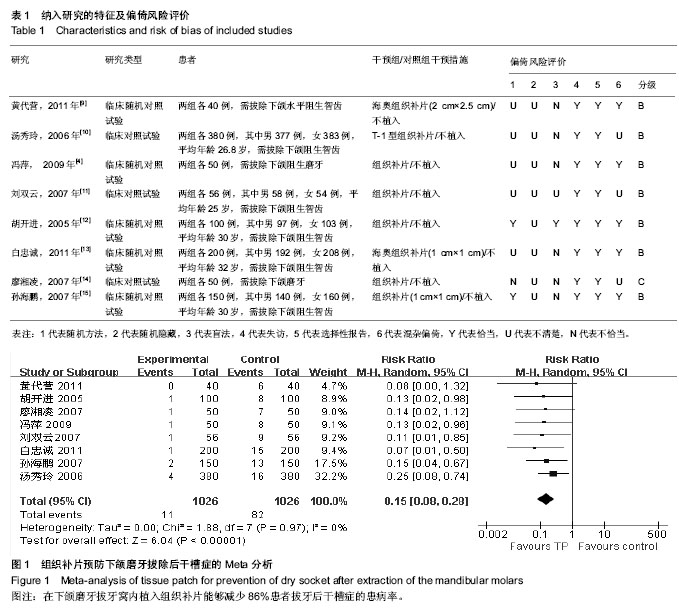| [1] Worrall SF,Riden K,Haskell R,et al.UK National Third Molar project: the initial report.Br J Oral Maxillofac Surg. 1998;36(1): 14-18.
[2] Torres-Lagares D,Serrera-Figallo MA,Romero-Ruíz MM,et al.Update on dry socket: a review of the literature.Med Oral Patol Oral Cir Bucal.2005;10(1):77-85.
[3] Blum IR.Contemporary views on dry socket (alveolar osteitis): a clinical appraisal of standardization, aetiopathogenesis and management: a critical review.Int J Oral Maxillofac Surg. 2002; 31(3):309-317.
[4] 冯萍,胡劲松,佘小明,等.口腔组织补片和富血小板血浆处理拔牙创的临床研究[J].口腔医学研究,2009,25(3):302-304.
[5] Murad MH,Montori VM,Ioannidis JP,et al.How to read a systematic review and meta-analysis and apply the results to patient care: users' guides to the medical literature. JAMA. 2014;312(2):171-179.
[6] Goldacre B.Meta-analysis of side effects of statins shows need for trial transparency.BMJ.2014;348:g2940.
[7] Chaiyakunapruk N,Saokaew S,Sruamsiri R,et al.Systematic review and network meta-analysis in health technology assessment.J Med Assoc Thai. 2014;97(Suppl 5):S33-42.
[8] Higgins JPT,Green S.Cochrane Handbook for Systematic Reviews of Interventions Version 5.0.1 [updated September 2008][M].John Wiley& Sons Ltd: Chichester, 2008.
[9] 黄代营,聂二民,郭俊兵,等.HEAL-ALL组织补片在拔牙后干槽症预防中的应用[J].中国组织工程研究与临床康复, 2011,15(29): 5409-5412.
[10] 汤秀玲,徐燕梅,杨惠清.T-1型组织补片应用于下颌阻生智齿拔除术的护理[J].中国实用护理杂志:下旬版,2006,22(11):36-37.
[11] 刘双云,张昀,张林祺,等.口腔组织补片预防干槽症疗效观察[J].白求恩军医学院学报,2007,5(1):29.
[12] 胡开进,孔亮,彭莲,等.口腔组织补片置入拔牙创预防术后并发症[J].实用口腔医学杂志,2005,21(2):214-216.
[13] 白忠诚,施生根,李莉莉,等.脱细胞异体真皮组织补片在智齿拔除中的应用[J].中国组织工程研究与临床康复, 2011,15(34): 6457-6460.
[14] 廖湘凌,殷鹏,吴斌,等.异体脱细胞真皮基质预防拔牙术后并发症的疗效观察[J].北京口腔医学,2007,15(3):168-169.
[15] 孙海鹏,冯力,翁汝涟,等.异体脱细胞组织补片置入拔牙创预防术后并发症[J].广东牙病防治,2007,15(3):102-104.
[16] Coulthard P,Bailey E,Esposito M,et al.Surgical techniques for the removal of mandibular wisdom teeth.Cochrane Database Syst Rev.2014;7:CD004345.
[17] Malkawi Z,Al-Omiri MK,Khraisat A.Risk indicators of postoperative complications following surgical extraction of lower third molars.Med Princ Pract.2011;20(4):321-325.
[18] Akinbami BO,Godspower T.Dry socket: incidence, clinical features, and predisposing factors.Int J Dent. 2014;2014: 796102.
[19] 邱蔚六.口腔颌面外科学[M].6版.北京:人民卫生出版社, 2008: 96-98.
[20] Parthasarathi K,Smith A,Chandu A.Factors affecting incidence of dry socket: a prospective community-based study.J Oral Maxillofac Surg.2011;69(7):1880-1884.
[21] Pal US,Singh BP,Verma V.Comparative evaluation of zinc oxide eugenol versus gelatin sponge soaked in plasma rich in growth factor in the treatment of dry socket: An initial study. Contemp Clin Dent.2013;4(1):37-41.
[22] Chemaly D.How do I manage a patient with dry socket?J Can Dent Assoc. 2013;79:d54.
[23] Upadhyaya C,Humagain H.Prevalence of dry socket following extraction of permanent teeth at Kathmandu University Teaching Hospital (KUTH), Dhulikhel, Kavre,Nepal: a study. Kathmandu Univ Med J (KUMJ). 2010;8(29):18-24.
[24] Sharif MO,Dawoud BE,Tsichlaki A,et al.Interventions for the prevention of dry socket: an evidence-based update.Br Dent J. 2014;217(1):27-30.
[25] Haraji A,Rakhshan V.Single-dose intra-alveolar chlorhexidine gel application, easier surgeries, and younger ages are associated with reduced dry socket risk. J Oral Maxillofac Surg.2014;72(2):259-65.
[26] Harirchian S,Baredes S.Use of AlloDerm in primary reconstruction after resection of squamous cell carcinoma of the lip and oral commissure.Am J Otolaryngol. 2013;34(5): 611-613.
[27] Ye WM,Zhu HG,Zheng JW,et al.Use of allogenic acellular dermal matrix in prevention of Frey's syndrome after parotidectomy.Br J Oral Maxillofac Surg. 2008;46(8):649-652.
[28] Li C,Yang X,Pan J,et al.Graft for prevention of Frey syndrome after parotidectomy: a systematic review and meta-analysis of randomized controlled trials.J Oral Maxillofac Surg. 2013; 71(2): 419-427.
[29] Zeng XT,Tang XJ,Wang XJ,et al.AlloDerm implants for prevention of Frey syndrome after parotidectomy: a systematic review and meta-analysis.Mol Med Rep. 2012; 5(4):974-980.
[30] Jhaveri HM,Chavan MS,Tomar GB,et al.Acellular dermal matrix seeded with autologous gingival fibroblasts for the treatment of gingival recession: a proof-of-concept study.J Periodontol.2010;81(4):616-625.
[31] Basegmez C,Karabuda ZC,Demirel K,et al.The comparison of acellular dermal matrix allografts with free gingival grafts in the augmentation of peri-implant attached mucosa: a randomised controlled trial.Eur J Oral Implantol. 2013;6(2): 145-152.
[32] Windisch P,Fazekas R,Fazekas A.Prosthodontic rehabilitation of immediately placed dental implants following soft tissue augmentation. Case report.Fogorv Sz. 2013;106(3):101-108.
[33] 李春洁,吕俊,苏乃川,等.用“系统评价和Meta分析报告规范”评价口腔医学领域中文Meta分析的报告质量[J].中华口腔医学杂志,2011,46(5):257-262.
[34] Booth A,Clarke M,Dooley G,et al.PROSPERO at one year: an evaluation of its utility. Syst Rev.2013;2:4.
[35] Burford BJ,Welch V,Waters E,et al.Testing the PRISMA- Equity 2012 reporting guideline: the perspectives of systematic review authors.PLoS One. 2013;8(10):e75122. 36
[36] Palmer SC,Craig JC,Jones A,et al.Celebrating 20 years of evidence from the Cochrane Collaboration: what has been the impact of systematic reviews on nephrology?Nephrol Dial Transplant.2014 pii: gfu232.[Epub ahead of print]
[37] Freshwater MF.Reviewing systematic reviews and analyzing meta-analyses.J Plast Reconstr Aesthet Surg. 2014;67(2): 291-293. |
